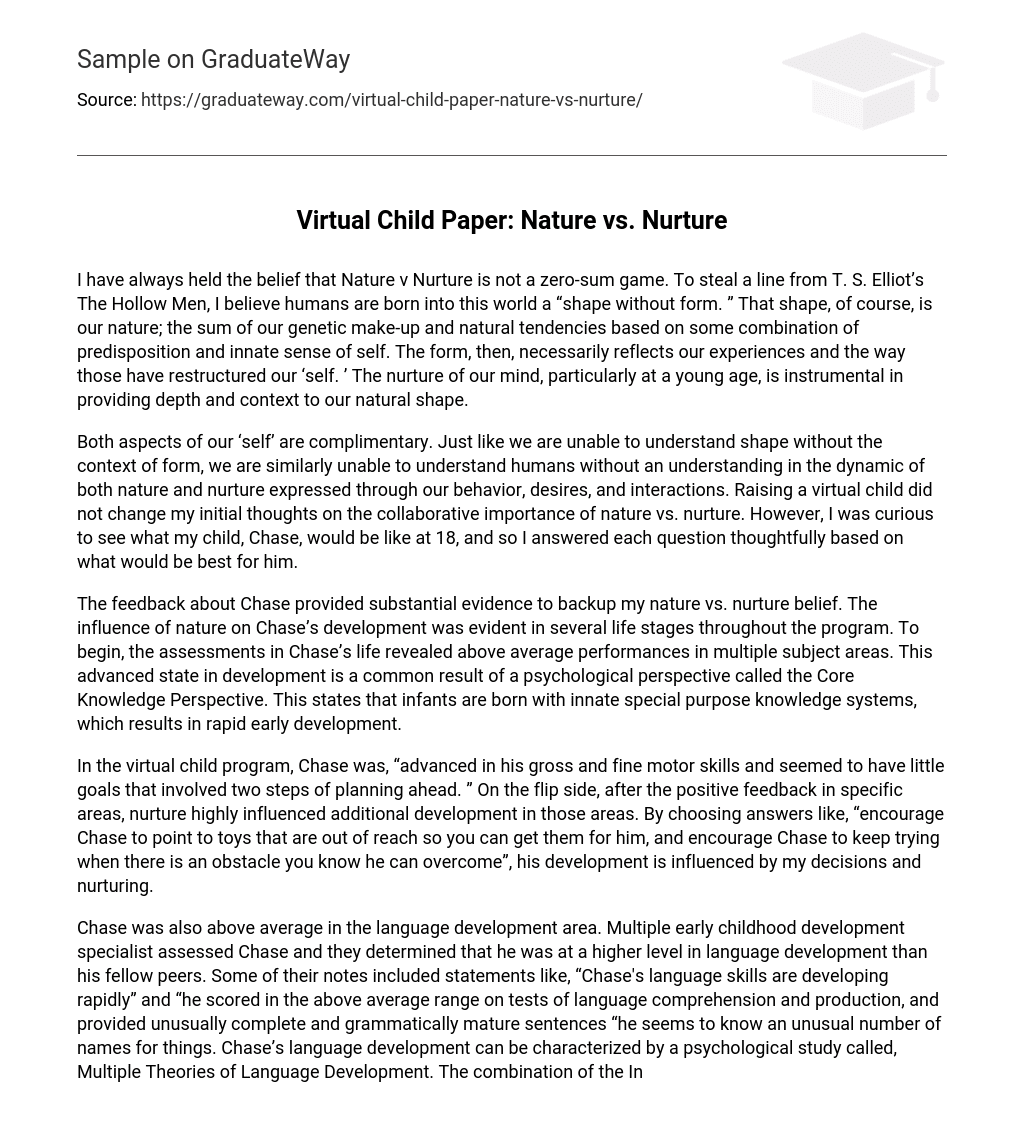I have always believed that the debate between Nature and Nurture is not a zero-sum game. In the words of T. S. Elliot’s The Hollow Men, I believe humans come into this world as a “shape without form.” This shape represents our nature, which is determined by our genetics and inherent inclinations. The form, on the other hand, is shaped by our experiences and how they have reshaped our sense of self. The nurturing of our mind, especially during our early years, plays a crucial role in adding depth and context to our innate nature.
Both aspects of our ‘self’ are complimentary. Just like we are unable to understand shape without the context of form, we are similarly unable to understand humans without an understanding in the dynamic of both nature and nurture expressed through our behavior, desires, and interactions. Raising a virtual child did not alter my original views on the collaborative significance of nature versus nurture. However, I was intrigued to observe the characteristics of my child, Chase, when he reached 18, so I carefully responded to each question considering what would be optimal for him.
The feedback on Chase provided strong evidence for supporting my belief in the nature vs nurture debate. The impact of nature on Chase’s growth was evident in various stages of the program. Firstly, the evaluations in Chase’s life demonstrated above average achievements in multiple subjects. This accelerated development aligns with the Core Knowledge Perspective, a psychological viewpoint stating that infants are born with specialized knowledge systems, leading to fast early progress.
The virtual child program revealed that Chase was proficient in both gross and fine motor skills, with a tendency to set small goals requiring two steps of planning ahead. However, it was observed that nurture played a significant role in further development, particularly in areas where positive feedback was received. By selecting options such as encouraging Chase to indicate toys that were beyond his reach and motivating him to persist when faced with obstacles he was capable of overcoming, my decisions and nurturing impacted his overall development.
Chase’s language development was assessed by multiple early childhood development specialists, who determined that he excelled in this area compared to his peers. They noted that his language skills were developing rapidly and that he scored above average on tests of comprehension and production. Moreover, Chase displayed an extensive vocabulary and demonstrated grammatically mature sentence construction. His advanced language development can be attributed to the combined influences of the Interactionist Theory and Behaviorist Theory, which consider inner capacities, environment, and social context. Therefore, it can be concluded that both nature (inner capacities) and nurture (environmental & social factors) contributed to Chase’s advanced language development. Recognizing signs of attachment in Chase, I promptly implemented various intervention strategies to prevent potential attachment issues in the future.
Attachment is a natural survival mechanism and serves to regulate proximity, security, and emotions. It is evident that attachment is influenced by innate factors. However, research indicates that children who experience feelings of attachment often develop long-term behavioral traits such as personality and communication skills. In Chase’s case, his attachment was apparent as he displayed negative reactions when faced with separation. He exhibited hesitation when parting with both my partner and me, and he began crying as soon as he was handed over to daycare.
Moreover, this behavior is connected to the sensitivity and responsiveness of the mother/caregiver and is correlated with the impact of nurture. Lastly, Chase had a larger-than-life personality; he was very extroverted and possessed an innate curiosity. His personality was shaped by the symbiotic relationship between nature and nurture. A specific examination of the scientific factors contributing to Chase’s temperament revealed a foundation rooted in nature. The genetic aspects contributing to temperament can be referred to as the Biological Basis for Temperament. Chase is characterized as uninhibited and extroverted, which is determined by factors such as positive reactions and openness towards new stimuli, low heart rates, reduced stress hormones, symtomps, and increased activity in the left hemisphere frontal cortex. Additionally, temperament is also influenced by nurture.
Therefore, his outgoing personality is the result of many factors like, his environment, relationships with family members, non-family peers, and etc. He was described as, “very outgoing and friendly with new people,” having “several good friends and gets invited to parties,” and “one of the most outgoing and popular seniors at the school. I tried to choose answers that introduced Chase to new situations and people. Consequently, nurture also played a significant role in shaping Chase’s outgoing temperament. In conclusion, my previous thoughts about the influence of nature vs. nurture on human development go unchanged. As mentioned above, both aspects of our ‘self’ are complimentary. Just like we are unable to understand shape without the context of form. The only change that may have occurred from the Virtual Child program is the reinforcement of my initial understanding of nature vs. nurture.





